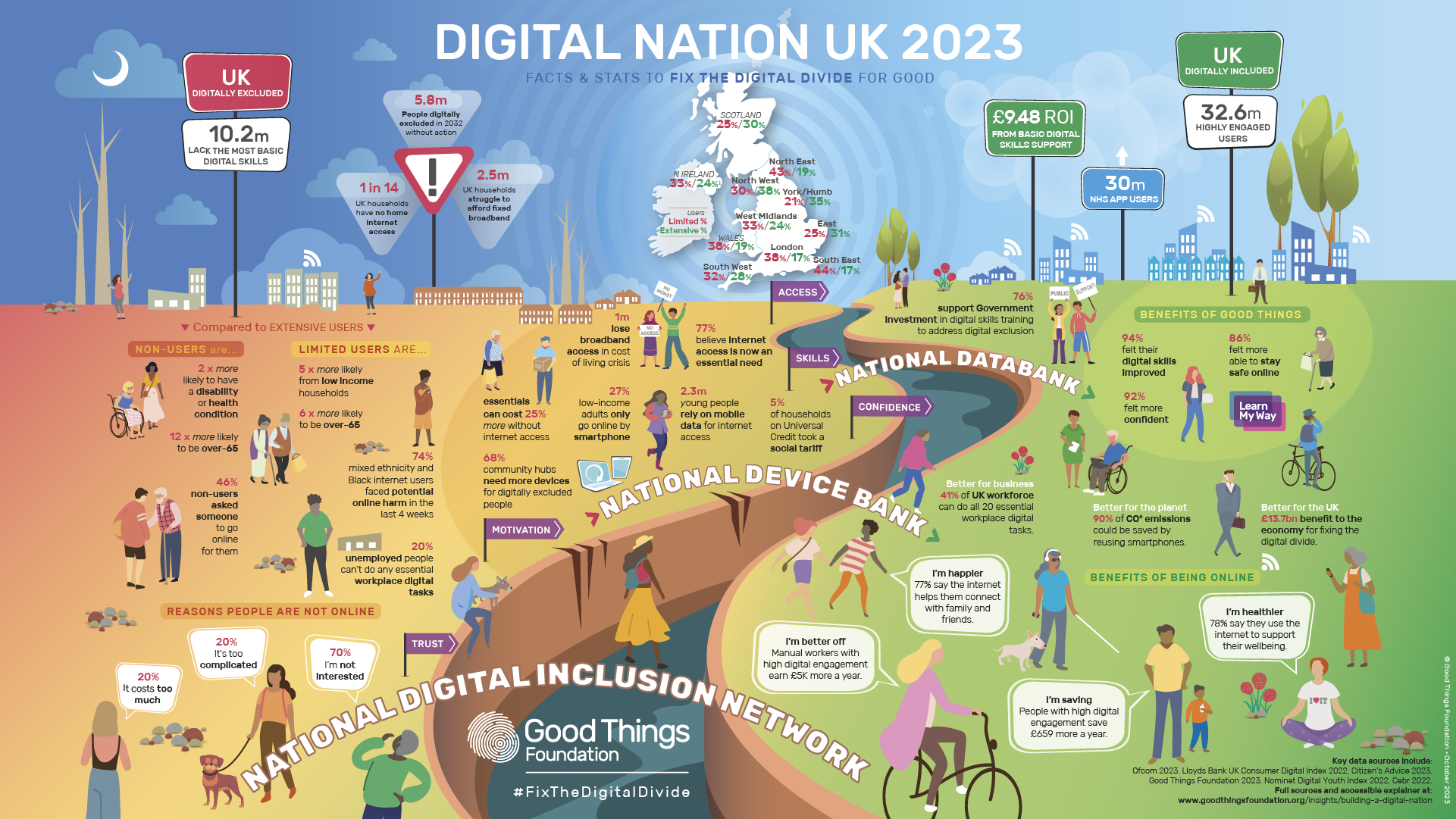With local authorities, the NHS and other services taking an increasingly digital-first approach, there is a real risk that people without access to digital resources are being left behind.
These digitally excluded people will be finding it increasingly difficult to access jobs, learning, housing, welfare benefits and health and social care.
Across the population, there are significant disparities in people’s access and capacity to use digital technologies in a society that increasingly takes a digital-first or a digital-only approach to the provision of services and to life in general. This is referred to as digital exclusion.
Millions of people in the U.K. are digitally excluded as shown in the powerful infographic below from the Good Things Foundation.

While the issue of digital exclusion is widespread, there are opportunities for change. I convened the Humber and North Yorkshire Digital Inclusion Network to bring together professionals and resources in our area to tackle digital exclusion across the Integrated Care System and partner agencies.
A moment in history
We are at a moment in history with digital literacy that mirrors the turning point when reading became a mainstream activity, however we are not there yet. Basic literacy gave communities power by democratising access to information that was previously available only to the ruling classes. In 2023, digital literacy has the potential to do the same. It is vital to recognise that there are thousands of people across the UK who lack the skills and resources needed to access digital technologies. They will struggle to access and make the most of tools that many people now take for granted.
A cultural shift is required
There is a mountain to climb to achieve the cultural shift towards everyone seeing digital exclusion as something they can and should do something about. We need large-scale promotion to make the population at large aware of the impact of digital exclusion and what they can do about it.
Change can occur at many levels. It might be a teenager helping their grandparent to use a smartphone. It could be a village hall providing access to the Internet. It might be a bank offering digital skills training or a Broadband provider offering social tariffs.
In the context of public services, we need funding and strategy on a national level that responds to this widespread need. When will we see organisations including digital inclusion in their strategy and policy documents? There is a role for professionals here on an individual level, too. Recognising when people need support and linking them with resources is key part of this systems change.
Networking for digital inclusion
Bringing organisations together is a good starting point to fix the digital divide. We have 154 members of the Humber and North Yorkshire Digital Inclusion Network ranging from volunteer-led community groups and faith groups to national charities and high street banks. We are funded by the NHS Integrated Care System (ICS). We come together weekly for optional drop-in sessions where we share stories, ideas, and challenges. We hold regular information events with organisations like the Good Things Foundation, ORCHA and Barclays Digital Wings. A newsletter goes out monthly to share the latest developments around digital inclusion.
After initial struggles to establish awareness of digital exclusion, we now have a good level of interest and many organisations with a desire to act. Sadly, a survey revealed that a lack of funding really holds back the potential of the voluntary, community and social enterprise sector to make the difference they could. They need staff, volunteers, space, devices, and reliable broadband.
Digital inclusion in action
Where funding is provided, we see digital inclusion in action. Our two Digital Inclusion Coordinators, funded by the ICS, help individuals get connected, obtain free data, and learn digital skills including how to avoid online fraud. They assist people to use the NHS App and attend online GP consultations. Network members tackle the key barriers to digital inclusion – connectivity, confidence, care, and/or kit. At present, we are operating in the context of an ongoing cost-of-living crisis where access to welfare benefits, grants, job application forms and learning opportunities too often assume a person has a digital device and the skills to use it. Good work is happening to address these issues – it’s just that we need more of it and for it to be sustainable and not reliant on goodwill or short-term funding.
Next steps in Humber and North Yorkshire
We have started to set up working groups to do deeper dives on specific issues around digital inclusion. These include basic literacy, accessibility, and alternative provision for those who will remain unwilling or unable to engage digitally.
We are encouraging individuals and organisations to make pledges about what they will do to tackle the digital divide.
Plans include new communications around how to converse with someone who finds themselves digitally excluded. Fear, overwhelm and embarrassment can make such conversations challenging. We need to move to a situation as where it is OK to be not digitally OK so that people feel able to ask for support.
Impact
In a recent survey of network members, 88% of respondents felt that the Digital Inclusion Project had successfully championed the needs of the digitally excluded.
We were delighted with this quote from one member:
‘I sense there is momentum building in the region which is driving an inclusive culture. The network has contributed to this by connecting people across the country and different sectors who are now collaborating to drive this discussion and give people the knowledge, confidence and resources needed to support each other.’
So are you ready to play your part in the huge challenge of digital exclusion? Will you help someone to become more digitally savvy? Can you raise the issue with policymakers? Who will be the celebrity champion for digital inclusion?
We at the Humber and North Yorkshire Digital Inclusion Network would love to hear your thoughts.



